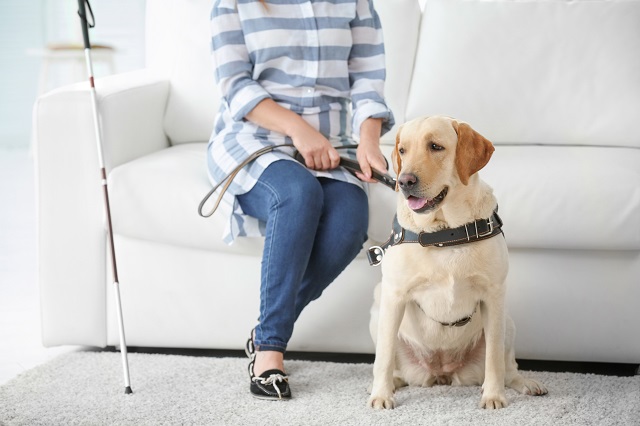
Welcoming a service dog into your home is a life-changing opportunity, and like all major life events, requires plenty of preparation. You’ll need to make some minor, but important, modifications to make your home accessible for your new companion. Use the following guide to optimize your home inside and out will help your service dog easily adapt to his new surroundings and help you navigate your daily tasks with ease.
The Exterior of Your Home
Even if you don’t plan to spend much time outdoors, there will still be some modifications you’ll need to make to the exterior of your home to ensure it is accessible and safe for your service dog.
Driveway and Garage
Whether you park in your driveway or garage, the key consideration for these areas is adequate space. If your service dog will assist you into and out of the car, there should be plenty of room for both of you to maneuver and load safely.
- Your driveway should be at least 12 feet wide to allow for easy access, though you may want even more space if you have large equipment to consider like a chair lift or ramp. This is especially important if you have a raised driveway or its edges are steep. Get a better estimate for your driveway project, then talk to a professional for a customized assessment.
- If you have two cars, you’ll want to consider moving the one you use least to the garage or street.
- Trim hedges or shrubs lining the driveway so your access is completely unimpeded.
An accessible garage is essential, particularly if you live somewhere that inclement weather conditions can make outdoor car loading complicated.
- If the floor is cement, tile, or another slick material, place a mat outside your usual seat that will allow you better traction while you get in and out of the vehicle.
- Clutter is the enemy, so maximize the overall space as much as possible with storage shelving and toss the things you don’t need anything you don’t need.
- Keep the garage regularly swept so that you and your service dog don’t track in dirt or debris. Also, take special care to clean up after DIY or home improvement projects.
Sidewalks and paths
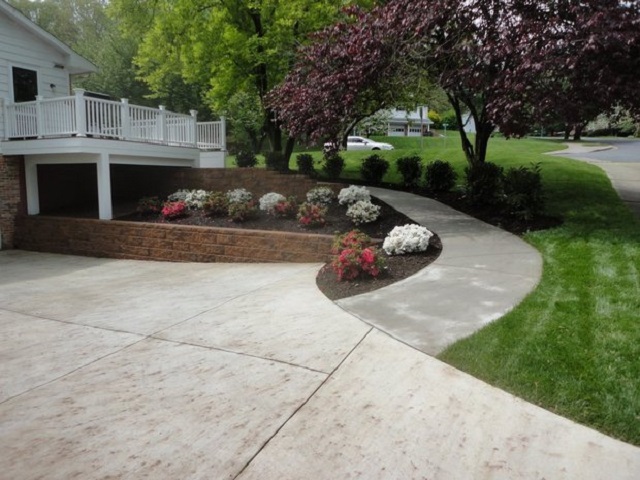
As with your driveway, you’ll want to ensure that any sidewalks on your property will comfortably fit you and your service dog.
- Those with upright mobility will want pathways between 24 and 48 inches wide to allow you and your companion to walk side-by-side.
- For those in a wheelchair, start with 36 inches and work your way up to 60 inches as needed.
- Be mindful of landscaping near and around paths — avoid shrubs that will need frequent trimming or monkey grass that can impede mobility.
Remember: your service dog is a whole new body to consider. You might be able to roll between the thorny bushes by the front door, but your helper will probably brush into them as he walks alongside you. If you need to update your outdoor paths, it’s important to know what material you’ll need and how much it will cost.
Yard
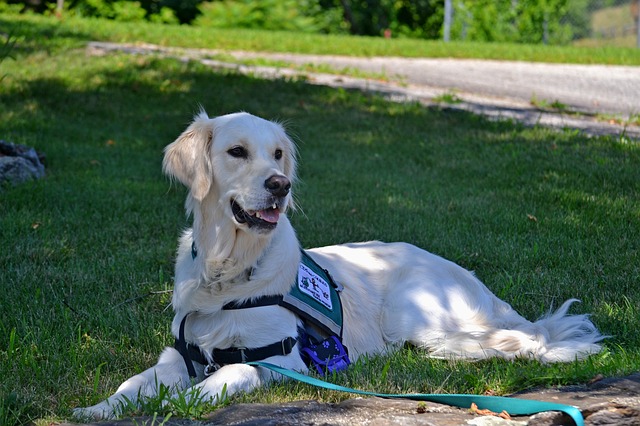
The backyard will need the right kind of fence if it doesn’t have one already. The company you’re working with will hopefully have valuable insight into what’s right for both the breed of your service dog and the area you live in. Generally, you’ll want something that’s at least six feet high. Most service dogs will be trained not to dig or venture away from home, but it’s still important to keep him contained; not only do you want to keep potentially dangerous predators out, you’ll want to prevent your service dog from fleeing your property while chasing a rabbit that’s sparked his prey drive. The more problems you can prevent completely, the better.
The Interior of Your Home
If you’ve had your disability for a long time, your house may already be pretty close to where it needs to be to make your dog comfortable. If your disability is relatively new and you haven’t made modifications already, it may make sense to make changes to your home for both you and your service animal at the same time.
It can be tricky and expensive to accommodate both you and your service dog, especially if you’re starting from scratch on modifications.
Here are a few resources that may be able to help:
- Grants for Home Modification: 16 Resources
- Common Home Improvement Projects for Homeowners with Disabilities
- Home Adaptations for Your Needs
Doors and doorways
The standard doorway width for wheelchair access is 32 inches, though it will depend greatly on the age and height of the individual and the kind of chair they use.
Keep in mind that for some, keeping the door frames as they are and planning to let your service dog lead the way through the house will be a completely viable option; establish what makes sense for your situation, communicate that to your service animal trainer, and make any necessary changes.
If necessary, you may be able to widen the doorways yourself if you’re handy. If it’s a load-bearing wall, consult a structural contractor before taking charge on the project. You could do more harm than good if you’re not experienced with this kind of work, putting both you and your companion in danger.
If widening your doors isn’t something you can do on your own, find out how much it will cost and who you need to contact, whether it’s an interior or exterior door.
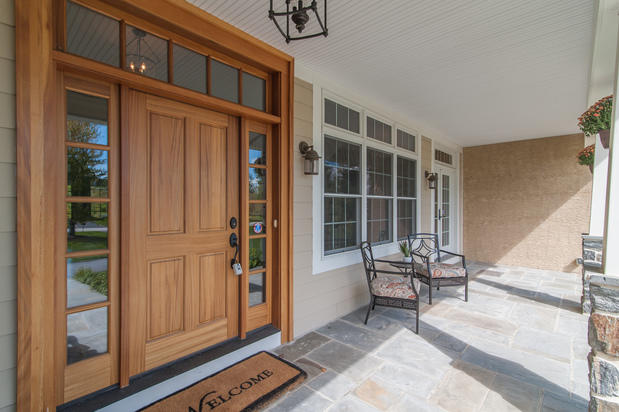
You’ll also need to give your service dog a way to open and close doors throughout your house. Because he won’t be able to physically turn the knobs, you’ll need to add “tugs” to each door you’d to give him access to. A tug is simply a long piece of material tied to the doorknob, which your service dog will pull open and closed as needed. If your upper body mobility is weak, you’ll need to plan on keeping most of your interior doors open during the day so that your companion is never hindered from reaching you. Your trainer may show you how to direct your dog for this kind of task, or you may work together to teach him how it all works.
You’ll also want to consider disabling some of the locks on interior doors, especially for your bathroom, bedroom, and kitchen. For some, it’s difficult to break the habit of constantly locking doors behind them, but it could cause a serious delay in your dog reaching you in an emergency. This is particularly crucial for those who are partially or completely blind and those with some degree of deafness — you’ll already be at a significant disadvantage in the midst of an emergency. You don’t want to lose precious seconds trying to unlock the door to reach your service dog and evacuate.
Hallways
The considerations to be made for your hallway will seem aesthetic, but they can make an important difference. If you have any décor, furniture, or wall hangings that fall around the height of your service dog — particularly in narrow hallways — you’ll want to consider relocating them. His path should be free of any and all obstructions so that he can quickly and easily maneuver through the house. Remember that often it will be the two of you together, so you’ll be broader as you move about. If it seems like a tight squeeze even before your service dog arrives, play it safe and clear the hallway as much as possible.
You’ll also want to ensure there’s adequate lighting in each hallway so your service dog can easily navigate the house no matter what time of day it is. Maximize any natural light you have (well-placed mirrors can re-direct light from another room), and if they aren’t already, paint your walls a bright color. Opt for overhead lighting or flat wall sconces if additional units must be added; even (flat) nightlights can brighten the path efficiently.
The Kitchen
Add tugs to the refrigerator and freezer doors, as well as any cabinets you’ll want him to access. Talk to your dog trainer about the kinds of kitchen tasks you foresee your service dog helping with:
- If you have limited upper mobility, perhaps he’ll need to help gather cooking supplies, put away groceries, and handle dishes.
- If you have weakness or limited mobility in your hands, he may need to help operate kitchen appliances.
- If you are blind or have deafness, you will need to be alerted to kitchen fires, smoke detector alarms, carbon monoxide alarms, and other hazards.
Space and accessibility are key; it’s both terribly inconvenient and potentially dangerous if you and your service dog have a tough time moving around the kitchen. The counter heights should be accessible to both of you, and items you use daily stored at waist-height. Lazy Susans, slide shelving, and pull-down shelves are great options for optimizing even the smallest of kitchens. Be incredibly mindful of how and where you store any potentially toxic items — keep them in cabinets, drawers, or on shelves that your service dog doesn’t have access to.
If your helper will be assisting you with cooking tasks, you’ll need to talk to the trainer about the specific modifications necessary for your kitchen, such as the oven, stovetop, refridgerator, and dishwasher. At the very least, your dog should be able to turn off these devices in case of emergency, particularly if you are blind or deaf.
Living Room
It’s vital that in general, your floor is clear and easily-navigated by both you and your service dog. In the living room, however, it’s typically easiest to use bins, baskets, and storage chests to keep extra blankets, pillows, remotes, books, and other miscellaneous items you may need; while these options will take up more floor space than closets, it will make retrieving much simpler for your canine helper. Go with a storage solution that either has an open top or a lid that allows him easy access whether he’s bringing you an item or putting objects away.
Bathroom(s)
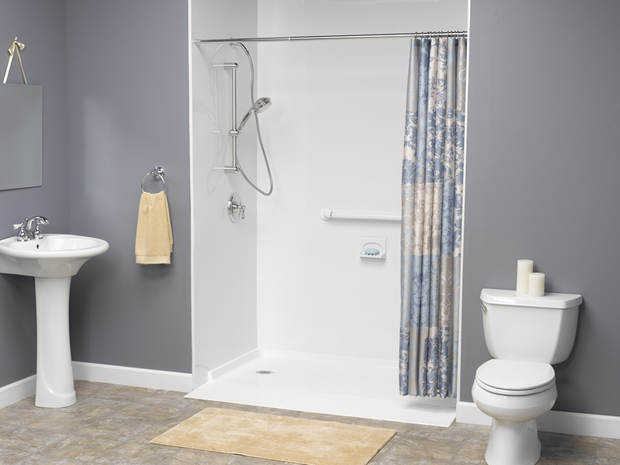
The bathroom can be a dangerous place even for those without a disability, so it’s important to get the necessary modifications done correctly.
Nonslip flooring is the first priority; a bathmat alone can increase traction and reduce slips and falls, but may complicate mobility for those who use wheelchairs or walkers, as well as pose a tripping hazard for people with limited vision. If you opt for slip-resistant coating, check the label carefully to ensure that it won’t be toxic for your service dog.
If your dog will help you with transport into and out of the shower, you’ll want to install grab bars to act as an additional means of support. Place at least one by the toilet, one outside of the shower or tub, and one within the shower or tub, and make sure each comes equipped with rubber gripping that will be easy to grasp even while your hands are wet. If possible, plan out exactly where your service dog will stand to assist you with each process so that both he and the grab bar(s) are within easy reach for each step.
Bathroom storage is another area where you should be strategic — keep cleaners tucked away in a closet or locked cabinet, but your daily supplies (toothbrush and toothpaste, hairbrush, hair dryer, etc.) somewhere easily accessible. Use baskets, vanities, or other low-rise storage options for towels and washcloths, adding tugs as necessary to give your service dog access.
Bedroom
You should plan to let your service dog sleep in your bedroom so he can immediately respond to any nighttime emergencies. Depending on your situation, your doctor may even recommend that the dog sleep in the bed with you so he can easily detect seizure activity, changes in your breathing patterns, or other medical issues.
If your service dog doesn’t need to be in the bed, designate a specific area on the floor for him to sleep. It should be somewhere near your bed but out of your path. If you have a medical alert device, ensure that it is kept within easy reach for both of you — keep it somewhere loose like on top of your nightstand instead of in a drawer.
If you use any large equipment for sleeping, you’ll want to make sure that cords are properly secured to or behind the wall and completely out of footing. Talk to the trainer about any assistance your dog will provide with these machines and the commands you’ll need to know; you might even want to write them down on a piece of paper and post it by your bedside until you know the list by heart. Practice them before your new helper comes to live with you so that you will feel more prepared if an emergency does arise.
General Accessibility
Lights
The good news is that although you’ll have to consider every light in your home, modifying them to be accessible to your service dog is usually pretty simple. Some service dogs are trained to flip wall switches with their teeth, others may rely on handheld buttons, and others still may use a combination of both throughout their owner’s home. Establish what kind of system will work best for your needs, and consider details like where you’ll keep each handheld switch, where dimmers might be appropriate, and whether some lights should be changed from a toggle switch to a push button.
Clear pathways and emergency routes
In general, you want your home to feel open. There should be clear, distinct pathways throughout the house with as little floor debris as possible. Establish fire escape routes for every room, keeping the areas around exterior doors clear and accessible. Go over these routes with the trainer and your service dog, and run fire drills from each room. It might seem overly-cautious, but in the midst of an emergency, you’ll feel better if you already know exactly how your service dog will respond and where you’ll go to get to safety.
Create a plan for every kind of inclement weather condition your area is prone to:
- Pick a secure spot for earthquakes and establish how your service dog will assist you when one strikes
- Have a flood evacuation plan that accounts for your canine
- Designate a tornado shelter with proper communication systems and supplies
- Plan for power outages: will your service dog need to help you access a backup generator or call for medical assistance if one of your medical devices fails?
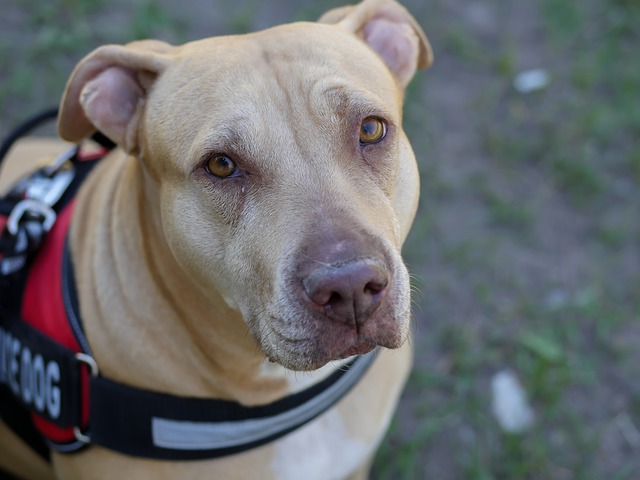
Additionally, you should establish how your pet will intervene in home security breaches:
- Does he know the sound of the security alarm (if you have one)?
- Do you have a safe room or closet that will fit both you and your service dog?
- If you’ll need any medication or devices (like an inhaler), does your dog know to grab them before following you into the safe room?
- Do you have a way that your dog can contact emergency services and/or a neighbor in the event of an emergency?
Prepare for every possible situation, and practice safety drills on a regular basis to keep the memory fresh. Keep emergency supplies throughout your home and ensure your service dog knows every location, as well as when he should grab which supplies.
Acoustics
Your service dog’s acute hearing abilities will work in your favor, but it’s still important to test the acoustics of your home and be aware of any “dead spots. You don’t necessarily want to guarantee that you can hear every sound that occurs in your house from anywhere in your house, but you do want to check that your service dog will always be able to hear you call for him. Ask the trainer or a friend to help you gauge which areas of the house inhibit sound. Place dog whistles or another alert device your companion will hear without question in any room that even could be borderline. You may end up never needing to use them, but it’s better to have them on-hand either way.
Your service dog will no doubt improve your life in all kinds of ways, so make sure you set him up for success. Consult your physician and the service pet trainer to decide which home modifications make the most sense for your home and abilities — and prepare for your life together.
 Remodeling With Seniors in Mind
Remodeling With Seniors in Mind  Remodel for Senior Living: Keeping Things Rolling Along
Remodel for Senior Living: Keeping Things Rolling Along  Home Adaptations for Your Needs
Home Adaptations for Your Needs  Retiring in Your Own Home: How Baby Boomers Can Age In Place
Retiring in Your Own Home: How Baby Boomers Can Age In Place  Modern Design Trends & Advice for Aging in Place
Modern Design Trends & Advice for Aging in Place 

Are You Familiar With This Topic? Share Your Experience.